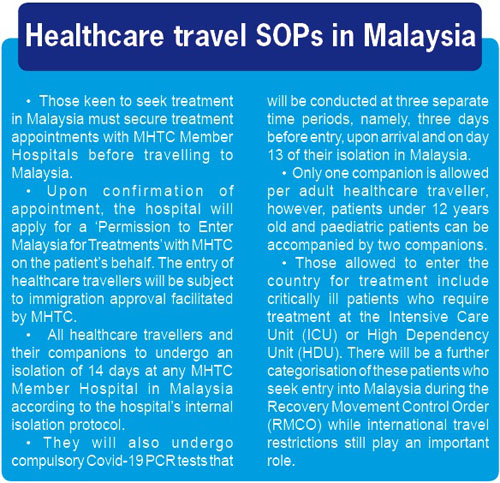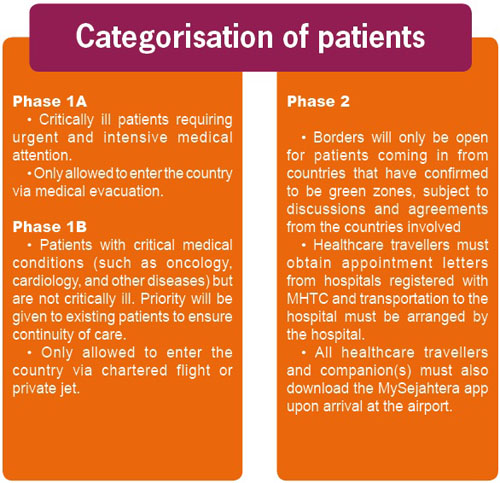Across the globe, the outbreak of Coronavirus Disease 2019 (Covid-19) has brought economies to a standstill as countries worldwide closed borders and implement lockdown measures in a bid to limit the spread of this fast-spreading virus and to not overwhelm the healthcare system in countries affected by the pandemic.
While these life-saving measures have proven to be effective in this fight against Covid-19, cross-border industries which depend on the foreign traffic are the most affected of all major economic sectors.
The medical tourism industry – also known as the healthcare travel industry – is one such sector badly affected by this pandemic despite being a key component in the Covid-19 fight.
Before the outbreak, Malaysia’s healthcare and its subsector, healthcare travel, experienced robust growth which was spurred by many factors.
These include difficulties in securing appointments, inflation in healthcare costs, development in ease of travel, demand for treatments supported with the latest technology and the rise of the world’s ageing population.
In a ‘Malaysia Healthcare Chronicles 2009 – 2019: A 10 year journey of Malaysia’s healthcare travel industry’ report, compiled by the Malaysia Healthcare Travel Council (MHTC), given the many growth factors and trends supporting the rise of healthcare travel, the report explained that the industry has continued to see robust growth, notably in recent years.
The global average compounded annual growth rate (CAGR) for the past five years has been 10 to 12 per cent, with a four per cent year-on-year growth, according to the World Tourism Organisation.
On the back of this healthy growth, in terms of revenue, Euromonitor stated that global healthcare travel‘s current receipts are estimated to be at US$16 billion and is expected to reach US$20 billion by 2022.
Over the past decade, Asia and specifically Asia Pacific (APAC) emerged as one of the fastest growing healthcare travel regions in the world.

MHTC noted that Malaysia, India, Thailand, Taiwan, South Korea and Singapore emerged as among the top 10 healthcare travel destinations in the world.
Nevertheless, like almost every sector affected by the pandemic, the healthcare travel industry’s growth in this region was hit hard by the restricted movements between countries.
In a post on the International Medical Travel Journal (IMTJ), based on a poll from attendees at its first webinar titled ‘Medical travel in a post-Covid world’, IMTJ noted that 42 per cent believed that the medical travel sector would continue to be significantly impacted by the Covid-19 outbreak for another six to 12 months.
“Covid-19 caused an unprecedented disruption to global tourism, the likes of which we’ve never seen before,” said UN World Tourism Organisation (UNWTO) officer in tourism market intelligence and competitiveness Michel Julian during an online stream highlighting the impact of Covid-19 on international tourism.
UNWTO expected there to be a 60 to 80 per cent decline in tourist arrivals by the end of this year, depending on when borders re-open and travel restrictions get lifted. Julian also predicted that while domestic tourism would recover first, international travel might not start to improve until 2021, and much would depend on whether and where there is a resurgence of the virus. For Malaysia, aware of the challenges posed by Covid-19, MHTC, an agency established to oversee the growth of Malaysia’s healthcare travel industry, has lowered its expectations of the growth of the healthcare travel market.
“We expect the healthcare travel market to be smaller in 2020 and 2021; for 2020 we have a revenue target of RM500 million by the end of the year, which is 70 to 75 per cent less than in 2019,” MHTC chief executive officer Sherene Azli said.
“We don’t have a clear picture of how many people are coming because this is a totally new environment. The travelling behaviour is different, and there are changes in the way we do things,” she told Bernama.
This week, BizHive takes a look at Malaysia’s healthcare travel industry and how it aims to cope during this Covid-19 era.

A thriving sector prior to the pandemic
Before the Covid-19 pandemic took its toll on healthcare travel, Malaysia was named one of the top performing countries for healthcare travel in the Asia Pacific (APAC) region.
The Global Market Report 2018 placed Malaysia as the world’s top healthcare travel destination by volume, outranking countries such as the US, South Korea and more.
According to Malaysia Healthcare Travel Council (MHTC), Malaysia’s eighth placed ranking outpaced many other famous locations, affirming the country’s unique ability to attract travellers from around the world.
In its ‘Malaysia Healthcare Chronicles 2009 to 2019: A 10 year journey of Malaysia’s healthcare travel industry’ report, MHTC explained that by healthcare revenue growth and healthcare tourist arrivals, for the year 2015 to 2018, Malaysia recorded a healthcare travel revenue of RM4.8 billion, an 80 per cent increase from RM2.6 billion recorded for the year 2011 to 2014.
Over the period of assessment for 2011 to 2018, the industry revenue recorded a compounded annual growth rate (CAGR) of 15 per cent.
Malaysia’s healthcare travel industry averaged a CAGR of nine and 15 per cent for revenue receipts and traveller arrivals respectively over the past 10 years with the peak of 17 per cent CAGR from 2015 to 2018, and according to MHTC, this was a commendable feat when measured against APAC’s performance of 15 per cent CAGR for the same period.
“In Malaysia, healthcare travel is a significant contributor to the national economy and has been recognised as an area for recovery as we move forward.
“Malaysia’s healthcare industry grew at a CAGR of 17 per cent between 2015 to 2019 against the APAC year-on-year growth of 12 to 14 per cent, showcasing the potential healthcare travel holds for the region.
“Our commitment to customer centricity has built trust among multinational healthcare travellers, resulting in a 22 per cent revenue increase of RM 1.72 billion in hospital receipts in 2019, which contributed a total of total economic impact of RM 6.6 billion,” MHTC chief executive officer Sherene Azli shared in an interview with BizHive.
“Once dubbed as the Hidden Jewel of Asia, Malaysia has now been recognised as the “Destination of the Year” by International Medical Travel Journal (IMTJ) for three years in a row between 2015 to 2017 and received ‘Highly Commended’ mentions in 2018 and 2019,” she added.
Malaysia’s healthcare system has also been internationally recognised by US-based International Living earning the title as the country with the ‘Best Country in the World for Healthcare’ based on their Global Retirement Index from 2015 to 2019 while in 2020, Malaysia attained the position as the ‘Top Asian Country for Retirement and Healthcare’.
Beyond healthcare services provided by hospitals under MHTC’s purview, the industry also has potential to compliment various other industries, bringing in even greater economic impact to the nation if out-of-hospital spending by the patient and his/her accompanying travellers (family, friends and caregivers) are factored in.
“With a multiplier effect of 2.24 of RM2.86 billion for spending on wellness, transport, accommodation, leisure and food, the healthcare travel industry has contributed a total of RM6.4 billion to Malaysia’s economy in 2018,” said MHTC in its industry report.
In terms of job creation, MHTC pointed out that the growing healthcare travel industry has enabled the creation of more than 15,000 skilled and even high-paying jobs.
“The result is the retention of highly skilled personnels and specialised local talents, which goes towards addressing Malaysia’s perennial issue of brain drain,” it said.
Rising interest in healthcare services in East Malaysia
Over in East Malaysia, there has also been a rise in interest for the healthcare services provided here.
MHTC had noted that Sarawak enjoyed a growth of over 60 per cent in healthcare travel revenue between 2011 and 2018, equivalent to RM84 million and a revenue CAGR of 16 per cent during the period, at par with the industry average of 15 per cent during the same time. Sabah, equally famed for its rich biodiversity and cultural elements, also saw rapid growth in recent years.
“The growth of tourism in East Malaysia had led to bright new prospects for medical tourism to shine in Sabah. Sabah experienced an exponential revenue jump between the period of 2011 to 2014 and 2015 to 2018, generating additional revenues of RM27 million.
“This growth was a result of full-fledged hospital players in Sabah investing in new, extensive facilities and aggressively promoting medical travel. Motivated by the potential of the state’s healthcare industry ecosystem, healthcare providers and the state government worked in hand-in-hand earning a revenue CAGR of 91 per cent from 2011 to 2018,” MHTC stated.

Sherene Azli
Regaining confidence for Malaysia’s healthcare system
Clearly, Malaysia’s healthcare travel industry has been on a rapid rise in recent years, with the nation gaining favourable reputation worldwide as the ‘go-to’ destination for quality healthcare services.
This year, Malaysia’s healthcare travel industry was supposed to see a huge growth, with a target of achieving RM2 billion in hospital revenue this year, especially given that the government’s aim to boost the travel and tourism industry here via ‘Visit Malaysia 2020’.
However, the Covid-19 pandemic has put a huge dent in this momentum.
Since the start of the outbreak, cross-border industries that depend travellers and tourists, struggle to find solutions to recover the industry in the current situation where movement between countries are now restricted to the absolute necessary.
In June, however, after almost three months of being under the Movement Control Order (MCO) and Controlled MCO (CMCO), the healthcare travel industry was announced as one of the first few industries that will be allowed to operate as the government announced the reopening the country’s international borders to healthcare travellers.
As Malaysia opens up its medical tourism industry, the question still remains on how it could recover as patients and visitors are still wary on traveling at this time.
Furthermore, Malaysia has to be extra cautious to protect its people as well as inbound patients during this time.
A silver lining in the industry
While the Covid-19 pandemic has mostly entailed ‘doom and gloom’ scenarios, there is, perhaps, a silver lining for Malaysia’s healthcare travel industry and its reputation for providing quality healthcare services.
The Global Covid-19 Index (GCI) recently ranked Malaysia as one of the top five countries effectively handling the Covid-19 crisis. As at time of writing, Malaysia’s Covid-19 recovery rate was at 96.13 per cent.
While not strictly reflective of Malaysia’s healthcare system, it does portray its ability to handle high-pressured situations like this.
“Malaysia’s excellent response in managing the Covid-19 pandemic locally has enabled the country to open a healthcare travel bubble and resume healthcare travel activities in a safe manner for both inbound patients and national security.
“With the healthcare travel bubble for healthcare travel coming into effect on July 1, we are gradually starting to rebound with stringent Standard Operating Procedures (SOPs) in place,” Sherene shared.
Short-term efforts for long-term sustainability
On its effort to lift Malaysia’s healthcare travel industry again, Sherene noted that much of MHTC’s short-term efforts are geared towards presenting Malaysia as the “World’s Healthcare Marvel”.
“Alongside our decades long history in delivering world-class quality healthcare services, Malaysia has emerged successful in managing and curbing the spread of Covid-19, highlighting our healthcare capabilities and strengths as a world-class quality healthcare provider.
“We believe that with Malaysia’s quality healthcare offerings and standard in hospitality, we will see an encouraging inflow of healthcare travellers post the Covid-19 period.
“We are also preparing for a healthy industry rebound through proactive and dedicated digital brand presence in our target markets as well as the adoption of telehealth by all hospitals to stay ahead of the curve and ensure continuity of care,” she explained.

Setting SOPs to safeguard Malaysia and incoming patients
As Malaysia reopens its international borders to healthcare travellers, several strict measures are being put in place to ensure the safety of both patients and Malaysians.
“Among the challenges faced with the implementation of the SOPs set by the Government is ensuring that every healthcare traveller has been screened prior to entering Malaysia for healthcare treatment.
“Malaysian authorities are consistent in their communication and cooperation with authorities abroad to ensure that screenings are performed, ensuring the safety for both the patient, those who come in contact with the patient throughout the journey, as well as safety within the Malaysian borders.
“On our part, the Malaysia authorities has prepared Covid-19 testing facilities and procedures as well as quarantine procedures, should the patient be found positive, to ensure continued prioritisation of safety for all,” Sherene explained.
Of note, as of July 22, according to a report by Bernama, MHTC has received approval for the second phase to allow healthcare travellers from six countries, namely Brunei, Singapore, Japan, South Korea, Australia and New Zealand, to travel to the country.


Technology a possible solvent to sector problems
While lockdowns are easing worldwide, travel restrictions are still in place for most countries. Also, sentiments regarding traveling abroad remain more or less low as consumers are still wary of traveling while there is still no vaccine for Covid-19.
One way around this is using technology as a possible bridge between patients overseas and doctors here. In countries where its healthcare system have been overwhelmed by the pandemic, patients have grown desperate in seeking medical attention elsewhere.
The pandemic has opened up talks about using technology for health consultations to reach out to these patients.
When asked on how hospitals can help patients overseas during this difficult period, MHTC’s Sherene had this to say, “Among the most promising opportunities to grow and remain relevant is to move online and embrace the digital sphere.
“During this unprecedented time, it is the digital world that has helped to keep us all connected.
“Most healthcare providers in Malaysia who provide healthcare travel services have also embraced digital transformation and we strongly encourage them to continue maximising their digital platforms,” she added.
Sherene further pointed out that one of the big evolutions that we have seen during Covid-19 has been the growth of the telehealth industry.

“It bridges the gap between patients, doctors and healthcare systems by allowing everyone to communicate with the medical professionals virtually.
“MHTC supports member hospitals by facilitating telehealth activities especially where policies are involved.
“If our patients lack access to medication and medical attention, they are provided with teleconsultation and telemedicine during this period. This enables continuity of care for the patient and with it, further builds trust towards the Malaysia Healthcare brand,” she said.
But with technology, there also comes the question of trust on its usage to communicate health-related question.
During a webinar hosted recently by Digital Health Malaysia on ‘How healthcare tourism thrives virtually in the Covid-19 era’, Dr Benjamin Cheah, a consultant physician and rheumatologist attached to Pantai Hospital Kuala Lumpur, Parkcity Medical Centre and IMU Medical Clinic, shared that while technology could help, there is still the question of trust.
Furthermore, he pointed out that regulations differ for healthcare consultations worldwide,
“We need better infrastructure and communications with other hospitals in other countries, as well.
“We also need better international partnerships. We need someone on the other side of the divide to be able to take up the case, in case complications occur post-surgery or post-care here.
“We need research and innovation because a lot of times, people come to Malaysia because we have more advance or newer treatments available here,” he noted.
“Healthcare is a relationship built on trust, dedication, and care.”
Overall, despite the ongoing health crisis ravaging the economies worldwide right now in the form of Covid-19, Malaysia is the top healthcare destination for many due to our world-class quality, ease of accessibility, and comparative affordability.
“Our attractiveness is also accentuated by other factors. These include Malaysia’s position as an ever-growing wellness sanctuary, our strategic position as a Muslim-friendly nation, its many travel sights, a multilingual healthcare system that caters to the language preferences of patients across Asia and the world.
“Moving forward, we aim to surpass our prime position in inbound patient volume to become the world’s leader by revenue with an aspirational US$1 billion by 2025, and ultimately become the leading global healthcare destination, cementing our position as the World’s Healthcare Marvel.
“In line with being the World’s Healthcare Marvel, Malaysia will keep on improving its healthcare system to ensure that the country remains safe for all healthcare travellers with our renowned medical expertise, as well as stringent regulations and procedures in place,” Sherene assured.
In the long run, she added, “Due to the pandemic, the Malaysia Year of Healthcare Travel campaign (MyHT2020) which was to be hosted in tandem with Visit Malaysia Year 2020, has been deferred to 2022, by which time we are optimistic that our healthcare travel activities would have resumed to partial normalcy.”
Over the next five years, Malaysia healthcare will continue to focus on three key initiatives; establishing Malaysia’s identity as the fertility and cardiology hub of Asia, establishing Malaysia’s identity as the centre of excellence for oncology, and the Flagship Medical Tourism Hospital Programme.
“Through these niche identities and key initiatives among many others, we believe Malaysia will be further propelled into the global landscape as the leading global destination for healthcare earning US$1 billion by 2025.”
Source: Borneo Post Online